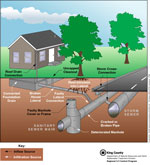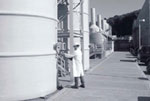|
 For more than 40 years, King County has protected water quality in the Puget Sound region by providing wastewater treatment services to King, Pierce, and Snohomish counties. For more than 40 years, King County has protected water quality in the Puget Sound region by providing wastewater treatment services to King, Pierce, and Snohomish counties.
 In the 1990s, flow estimates based on projected population growth estimates in King County's wastewater service area indicated that King County's regional wastewater treatment system would run out of capacity by 2010 (check out the tutorial). To ensure the continuation of high quality wastewater treatment services in the future, King County carried out an intensive planning effort, involving numerous elected officials, representatives from local sewer agencies, organizations and individuals from around the region. The Regional Wastewater Services Plan (RWSP) resulted from these efforts, which was adopted by the King County Council in November 1999 via Ordinance 13680. In the 1990s, flow estimates based on projected population growth estimates in King County's wastewater service area indicated that King County's regional wastewater treatment system would run out of capacity by 2010 (check out the tutorial). To ensure the continuation of high quality wastewater treatment services in the future, King County carried out an intensive planning effort, involving numerous elected officials, representatives from local sewer agencies, organizations and individuals from around the region. The Regional Wastewater Services Plan (RWSP) resulted from these efforts, which was adopted by the King County Council in November 1999 via Ordinance 13680.
The RWSP outlines a number of important projects, programs, and policies for King County to implement through 2030, and work is well underway. A summary of the major components of the RWSP follows.
Brightwater Treatment System
 The RWSP calls for building a new treatment plant by 2010, now known as 'Brightwater', to accommodate growth in the northern portion of our wastewater service area. The Brightwater System will include a 36 million gallons per day (mgd) treatment plant, conveyance (pipes and pumps that take the wastewater to and from the plant), and a marine outfall that will discharge effluent (treated wastewater) from the Brightwater Treatment Plant into Puget Sound. The Brightwater conveyance system consists of approximately 14 miles of pipeline built in underground tunnels. Visit the Brightwater project Web site for more information. The RWSP calls for building a new treatment plant by 2010, now known as 'Brightwater', to accommodate growth in the northern portion of our wastewater service area. The Brightwater System will include a 36 million gallons per day (mgd) treatment plant, conveyance (pipes and pumps that take the wastewater to and from the plant), and a marine outfall that will discharge effluent (treated wastewater) from the Brightwater Treatment Plant into Puget Sound. The Brightwater conveyance system consists of approximately 14 miles of pipeline built in underground tunnels. Visit the Brightwater project Web site for more information.
Conveyance System Improvements
 King County's regional wastewater conveyance system consists of more than 335 miles of pipes and 42 pump stations that move wastewater from local communities to the county's two regional wastewater treatment plants. The RWSP calls for improvements to our conveyance system to meet the twenty-year design storm and accommodate increased flows where needed. Visit the Conveyance System Improvement Program's Web site for more information. King County's regional wastewater conveyance system consists of more than 335 miles of pipes and 42 pump stations that move wastewater from local communities to the county's two regional wastewater treatment plants. The RWSP calls for improvements to our conveyance system to meet the twenty-year design storm and accommodate increased flows where needed. Visit the Conveyance System Improvement Program's Web site for more information.
>>back to top Regional Infiltration and Inflow Control
 The RWSP calls for improvement to reduce existing and future levels of infiltration and inflow (I/I) into local collection systems. I/I is clean stormwater and groundwater that enter the sewer system through cracked pipes, leaky manholes, or improperly connected storm drains, down spouts, and sump pumps. Most inflow comes from stormwater and most infiltration comes from groundwater. I/I affects the size of King County conveyance and treatment systems and, ultimately, the monthly rates that businesses and residents pay to operate and maintain them. Visit the Regional I/I Control Program's Web site for more information. The RWSP calls for improvement to reduce existing and future levels of infiltration and inflow (I/I) into local collection systems. I/I is clean stormwater and groundwater that enter the sewer system through cracked pipes, leaky manholes, or improperly connected storm drains, down spouts, and sump pumps. Most inflow comes from stormwater and most infiltration comes from groundwater. I/I affects the size of King County conveyance and treatment systems and, ultimately, the monthly rates that businesses and residents pay to operate and maintain them. Visit the Regional I/I Control Program's Web site for more information.
Combined Sewer Overflow Control
 The RWSP calls for the control of all county combined sewer overflows (CSOs) by 2030. Combined sewer overflows (CSOs) are events where untreated wastewater and stormwater from combined sewers discharge directly from outfall pipes into water bodies during heavy rainstorms when sewers are full. The RWSP calls for the control of all county combined sewer overflows (CSOs) by 2030. Combined sewer overflows (CSOs) are events where untreated wastewater and stormwater from combined sewers discharge directly from outfall pipes into water bodies during heavy rainstorms when sewers are full.
Combined sewers, which carry both wastewater and clean stormwater, exist in many parts of older cities across the nation, including Seattle. To protect treatment plants and avoid sewer backups into homes, businesses, and streets, combined sewers in Seattle sometimes overflow at specific locations (CSOs) into Puget Sound, the Duwamish Waterway, Elliott Bay, Lake Union, the Lake Washington Ship Canal, and Lake Washington. Although the wastewater in CSOs is greatly diluted by stormwater, CSOs may be harmful to public health and aquatic life because they can carry chemicals and disease-causing pathogens.
Approximately 17 of King County's 38 CSOs are controlled. Efforts to control CSOs began in the late 1970s. Since 1988, when monitoring and measuring of CSO flows began, these control efforts have reduced CSO volumes by nearly 60 percent. Visit the CSO control program Web site for more information.
The RWSP CSO control policies also call for development of a long-range sediment management strategy to prioritize cleanup of contaminated sediments at specific CSO locations. Visit the Sediment Management Program Web site for more information on the efforts to clean up contaminated sediments.
>>back to top Odor Control Program
 The RWSP includes policy guidance to achieve King County's odor control goal to prevent and control nuisance odor occurrences at all treatment plants and associated conveyance facilities and to carry out an odor prevention program that goes beyond traditional odor control. Visit the Odor Control Program's Web site for more information. The RWSP includes policy guidance to achieve King County's odor control goal to prevent and control nuisance odor occurrences at all treatment plants and associated conveyance facilities and to carry out an odor prevention program that goes beyond traditional odor control. Visit the Odor Control Program's Web site for more information.
Biosolids Recycling
 The RWSP policies guide the county to continue to produce and market Class B biosolids and to evaluate alternative technologies to produce the highest quality marketable biosolids. Biosolids are the nutrient-rich organic material produced by treating wastewater solids. After processing and treatment, they can be beneficially recycled as a fertilizer and soil amendment. Visit the Biosolids Program Web site for more information. The RWSP policies guide the county to continue to produce and market Class B biosolids and to evaluate alternative technologies to produce the highest quality marketable biosolids. Biosolids are the nutrient-rich organic material produced by treating wastewater solids. After processing and treatment, they can be beneficially recycled as a fertilizer and soil amendment. Visit the Biosolids Program Web site for more information.
Reclaimed Water
 The RWSP calls for the county to pursue and explore opportunities for expanded water reuse at the county's existing treatment facilities. The policies also call for the county to explore water reuse opportunities at all new treatment facilities. Visit the Reclaimed Water Program Web site for more information. The RWSP calls for the county to pursue and explore opportunities for expanded water reuse at the county's existing treatment facilities. The policies also call for the county to explore water reuse opportunities at all new treatment facilities. Visit the Reclaimed Water Program Web site for more information.
>>back to top For More Information
- Check out the RWSP Library for more details on the development and implementation of the Regional Wastewater Services Plan.
- For more information on the RWSP, please contact Debra Ross by e-mail or at 206-684-1531.
- For more information about Wastewater programs, view the Contact Us Web page.
>>back to top
RWSP Home | Library/Resources | Tutorial | Contact Us
|
